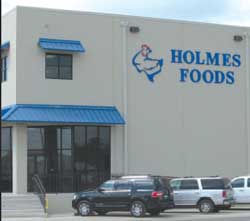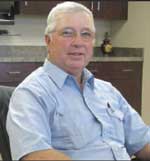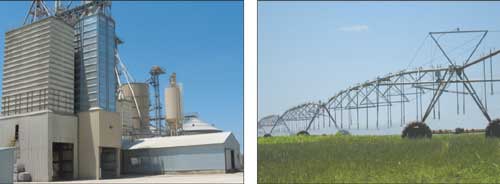



Goal Not To Be the Biggest – Just the Best
Profile on Holmes Foods where folks really enjoy being in the poultry business, according to Pete Sbanotto writing in the latest issue of Cobb Focus.When you think of US poultry companies, the names that come to mind are typically the largest such as Tyson Foods, Pilgrim's Pride Corporation, Perdue Farms or Sanderson Farms. But in the central Texas hill country is the town of Nixon, population 2,188, where Holmes Foods has its main office and processing plant. Pete Sbanotto visited Nixon to find what makes the business so special.

Ranked by the Watt Poultry USA survey in 2009 as 30th in size out of 37 poultry integrators, the family-owned Holmes Foods company certainly would not pretend to be among the giants of the industry. But that is not a concern of the Lester family – S.R. (Pal) and brother Tom, and Pal's son, Ricky. The focus of these owners, with president and CEO Phillip Morris, is performance and quality.
Holmes Foods began in 1925 as ice plant and began doing 'backyard processing', according to Ricky Lester, with the slaughter done across the street in what is now the parking lot. The business grew into a processor of turkeys, heavy hens, broilers and even ducks.
This developed into a co-op with the Holmes Foods 'Fresh Texas Chicken' doing the processing, feed supplied by S.R. Lester and Sons, and the hatchery owned and run by Ricky Lester. These three operations were combined in 2000 into the Holmes Foods Company, with the Holmes name retained because it was known for the processed products.
Today, Holmes Foods produces and slaughters 700,000 broilers per week averaging 4.00 to 4.10lb (1.8 to 1.9kg) each. These products are sold through distributor channels to specialty markets and food-service customers, with about 40 per cent marinated to customer specifications. An eight-piece cut is also a large portion of the processing in the plant, which employs 310 of the company's 400+ employees.

below: Phillip Morris

The business is growing, but this is always geared to customer needs – with no desire to grow just for growth's sake. Upgrading and modernizing is going on all the time, with the emphasis always on producing the best quality product at every level.
Currently Holmes Foods buys breeding stock from Cobb, placing over 250,000 Cobb 500 fast feathering females per year. "It is not just a meat producer, but we get eggs, too!" says Morris. The last flock of Cobb females produced just over 166 hatching eggs per hen. Eggs are produced for the hatchery from 12 pullet houses and 24 production houses. Recent remodels and new construction have upgraded all the breeder houses to tunnel ventilated, evaporative cooled, computer-controlled ventilation systems with mechanical egg gathering nest systems.
The Cobb broiler perfectly fits the processing needs of Holmes Foods, as well as bringing the advantages of feed conversion and yield. In fact, a recent flock achieved results better than the best listed broiler flock for that weight range in the last edition of Agri Stats, the renowned US poultry statistical reporting service. The Cobb bird, along with the quality of feed, baby chicks and broiler management, has shown extremely consistent results over a number of years. Currently there are 36 broiler farms with a combined total of 189 houses, growing the birds to processing weight by 34 to 35 days.
Bill Peterson, vice president andlive operations manager, oversees the complete process of getting quality birds to the processing plant. He has been described as 'the chicken chemist' by Ricky Lester, broiler grower as well as an owner. He said: "Bill will go into a chicken house and study every detail. He will think of everything that can affect the birds and try new things to get even better performance from the broiler."

centre: Tom Lester, Sr
bottom: Ricky Lester


The feed is supplied to these flocks through a mill that produces from 2,100 to 2,800 tons of pelleted feed per week. Since the cost of the feed is around 65 per cent of the total cost of a live pound of chicken, quality is the most important factor. The team members at the feed mill, led by mill manager Roger Crouch, accept the challenge of consistent quality, including a plus/minus variation of one per cent for each ingredient. If mistakes are made, the attitude is 'never let them get to the bird'. The proof of the feed quality is in the fact that in the last six-and-a-half years, the broiler feed conversion ratio had not varied more than two per cent.
Joe Weber, breeder/hatchery manager, supplies the grow-out department with quality baby chicks at the proper time and quantity. Unique to this operation is a combination of single and multi-stage hatching machines where birds can be hatched and placed five days a week. This allows for more control of the very tight weight specifications of birds coming to the plant. The hatchery was expanded in 2005 with plans for the future and the ability to eventually hatch one million chicks per week.
Dan Crozier is the grow-out/live haul manager for Holmes Foods. With the help of three service personnel, the chicks are taken to the grow-out farms, and all aspects of producing broilers are monitored to achieve the best livability, growth rate and efficiency.
With the desired weight being attained at an average of 34.8 days, the advantage of hatching five days every week coupled with the upgraded broiler houses allows the birds to be marketed at the target weight five weeks to the day from hatch, avoiding the weight swings from keeping birds in the grow-out facilities over the weekend. "The Cobb bird is very consistent," said Phillip Morris. "It performs the same all the time with no surprises. The uniformity gives us more birds in the weight range we need for our customers."
The products are specifically processed to requirements of each customer. Many are local restaurants and food-service providers receiving individualized service from Holmes Foods sales manager and senior vice president Phil Hartung. The processing of the birds is directed by Fred Barlow, vice president and plant manager, and is done in a building recently renovated and expanded by 44,000 square feet.
Continuous improvements in the plant have reduced the water usage per bird processed to one of the lowest in the nation, and at a level of only 30 per cent of years past. But the efficiency of the water use does not just stop there. With the small population of Nixon, the Holmes Foods processing plant generates around half of the wastewater for the whole town. The Lester family has used this opportunity to help the town and make use of the wastewater by developing a three-lagoon aeration/treatment system to purify the water which is then spread on hay meadows through an irrigation system over 2,000 feet long.
The forage harvested from the meadows is then used to help feed over 200 steers per year sold at the local cattle markets. This is a great commitment to preserving the environment. But when it gets dry in the Texas summertime, the irrigation is certainly a boon for keeping the forage growing!
From purchasing breeding stock to using processing wastewater, Holmes Foods can be summed up in three words – quality, efficiency and profitability. When asked to describe what words best describe the Holmes Foods' history, Ricky Lester simply states: 'Family' and 'a good time'. From meeting in the president's office to exchanging chili recipes with women in the processing plant, here are folks who really enjoy being in the poultry business.

right: Processing wastewater used to help make forage
July 2010








